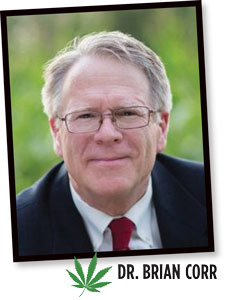11/1/2019
Will the CBD Boom Become a Bust?
Dr. Brian Corr

In the first of these columns, I wrote the cannabis industry was something of a wild, wild, West gold rush—booming, but subject to risk of a bust. We may be on the brink of a bust in one segment.
Studies have shown CBD to have efficacy in treating some seizure disorders and insomnia, and for reducing anxiety and inflammation. Many other benefits are claimed as well. The Mayo Clinic, Harvard Medical School, and other well-respected institutions regularly discuss the medical use of CBD (non-psychoactive cannabidiol). Cannabidiol is being written about not only by physicians, but articles appear almost daily in periodicals from Consumer Reports to Vanity Fair to Forbes to American Veterinarian.
In 2014, sales of legal CBD consumer products in the U.S. was estimated to be $108 million. Five years later, the estimate for 2019 CBD sales has boomed to $813 million. Walgreens, GNC, CVS, Ulta Beauty, and other well-known national chains are selling CBD products. So are the local vape stores, convenience stores and gas stations.
So, if demand is exploding, respected organizations are discussing its merits, reports are in the public discussion daily and distribution is ubiquitous, why do I suggest there may be a CBD bust? Several reasons come to mind, but an explosion in supply is a main contributor.
In the U.S., the 2018 Farm Bill authorized states to establish programs allowing for legal production of hemp. While some states have lagged, most set up reasonable programs for field production. While acreage is still being tabulated, a recent estimate concluded over 510,000 acres of hemp were approved to be planted in 2019.
Not every acre that’s approved will be planted (due to poor weather, lack of planting stock availability, change of heart, etc.). Further, not every acre that’s planted will be harvested, not everything harvested will be successfully dried and processed, and not every acre planted and harvested was intended for CBD extraction (hemp is also grown for seed and fiber production).
If all that U.S. production isn’t interesting enough, China is rapidly increasing production of cannabis for CBD. Canadian field production is increasing, as it is in many other countries, and all are eyeing the U.S. market.
There are many hypotheticals that influence how much CBD will be produced in comparison to consumption—some experts have suggested production may outpace demand by eight times. Maybe, maybe not. Regardless, it’s sufficient to say there’ll be a WHOLE LOT of CBD produced and demand, while strong, needs to continue to grow at a rate that seems unlikely. Even if you project consumption to double and production to remain flat, the numbers don’t look good.
One factor which will influence CBD demand is the remnants of legal restrictions. The U.S. Food and Drug Admini-stration (FDA) continues to make noise about regulating CBD. At minimum, the boilerplate FDA disclaimer is now required to be displayed on CBD products: (“The statements made regarding these products have not been evaluated ...”).
The FDA continues to explore other regulatory activities. Although smart money says the opportunity for the FDA to set stringent restrictions passed long ago, there still remains the possibility they may set some restrictions, which could make production, sales or use of CBD more difficult.
Another issue is individual U.S. states are inconsistent in their regulations. Early in 2019, Idaho police seized a truckload of industrial hemp being transported through Idaho from Oregon to Colorado. The truck driver has been charged with trafficking “marijuana” and could face five years in prison. The cargo, worth $1 million, remains in custody of the Idaho state police, much to the financial detriment of the company hoping to process it and sell CBD. This is at least the second time this has happened in Idaho.
At the time of this writing, there have been over 800 incidents of lung damage associated with e-cigarette use and about a dozen deaths. At this moment, the cause is unknown, and there’s no clear link to CBD, but what has come out very clearly is some CBD products aren’t what they claim to be. The Associated Press has reported some vape cartridges that were supposed to contain CBD were found to be spiked with illegal drugs commonly called K2 or Spice. Mississippi authorities have found fentanyl in some CBD products. Well-publicized studies have found some CBD products have much less CBD than claimed and some contain no CBD at all.
These findings will force some of the disreputable companies from the CBD market and will give reputable companies the opportunity to promote their reliability. However, with every report of contamination or inaccurate concentration, damage is being done to the perception of CBD as a compound with healthful properties, potentially impacting demand.
What will be the impact of all this? I’ve said many times, when it comes to cannabis, the crystal ball is notoriously hazy. But whether the CBD boom turns into a bust is worth watching. GT
Dr. Brian Corr is a consultant with more than four decades of experience in the greenhouse industry. He has advised legal cannabis producers for the last five years. You can reach him at Brian.Corr@SycamoreHortConsulting.com.